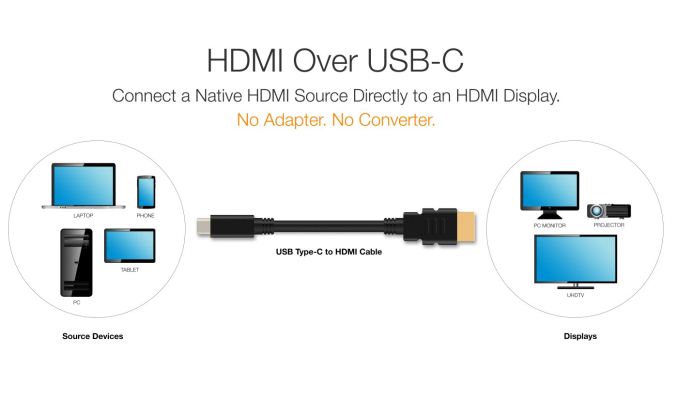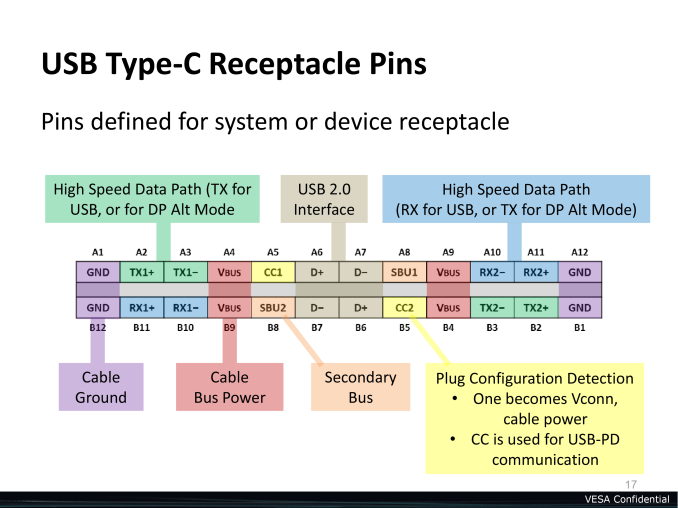HDMI Alt Mode for USB Type-C Announced
by Ryan Smith on September 2, 2016 9:30 AM EST
Over the past year we have seen an increasingly number of vendors, associations, and consortiums lay their support behind the USB Type-C port and take advantage of its alternate mode capabilities. Via alternate modes, a portion of the pins can be reallocated to carry signals other than USB SuperSpeed data, allowing a single port to be a USB port, data port, a display port, and more. This week the HDMI consortium has become the latest group to make use of the alt mode functionality, announcing the HDMI alt mode specification.
Like the other specifications using the alt mode feature, the development of an HDMI alt mode is intended to give laptops and other devices the option of outputting HDMI video over a Type-C port, rather than requiring a separate HDMI port. This saves space and can simplify the process of hooking up an HDMI display, all the more important as devices continue to get thinner and USB-C ports become more common. The addition of an HDMI alt mode means that device manufacturers, when devices are suitably configured, can now offer a direct HDMI connection over USB-C from their devices using a simple cable. Previously the only way to offer HDMI via USB-C was to first pipe out DisplayPort, and then covert that to HDMI, which requires a more complex full protocol adapter.
Digging into the announcement, it’s interesting to note that the alt mode specification is for HDMI 1.4b, and not HDMI 2.0, which means that the maximum resolution with full chroma subsampling is 4Kp30. The latter 2.0 specification uses the same pins, just at a higher data rate, so I’m not sure if there’s some kind of technical limitation in play here, or if the consortium had other reasons to favor 1.4b. Few mobile devices can output 4Kp60 video right now, however laptops with dGPUs are already there, and eventually iGPUs will get there as well. Otherwise the full HDMI feature set is supported, including the audio return channel, CEC, and the Ethernet channel.
Meanwhile the HDMI consortium hasn’t released too much in the way of technical details for how the pin configuration works, so there are a few holes here. As we’ve already seen with DisplayPort’s alt mode, you can typically use 11 pins for an alt mode – the 8 SuperSpeed pins, the 2 SBU pins, and one of the CC pins – and ignoring the 4 shield pins of the HDMI connector, I’m not sure how this maps to the remaining 15 pins of an HDMI connector. The consortium notes that this is meant to enable HDMI over a “simple cable,” so if a chip ends up being required, I’d expect it to be equally simple.
One thing to note though that compared to the existing DisplayPort alt mode, HDMI requires all 4 of its high speed data/clock lanes to operate, so it doesn’t appear that there won’t be an option to have a cable carry a mix of HDMI video and USB SuperSpeed data. This means that manufacturers that make multi-port adapters with both USB 3.0 and HDMI – like Apple’s Digital AV Multiport Adapter – will still need to utilize DisplayPort-to-HDMI conversion to make the necessary lane allocations work. The HDMI alt mode, in this respect, seems far more focused on just directly connecting devices with HDMI displays, with maybe a USB-C pass-through for power.
In any case, the HDMI consortium expects the first HDMI alt mode capable devices to be announced early next year, possibly in time for CES 2017. Like the other alt modes, manufacturers do need to build in support for the HDMI alt mode – typically using a simple mux – so whether a device supports this alt mode will vary on a case-by-case basis. But given how popular HDMI is, if it’s easy (and cheap) to implement I wouldn’t be surprised to see pretty wide adoption for this alt mode in laptops and other devices that already have HDMI capabilities.
Source: HDMI Consortium












68 Comments
View All Comments
Senti - Friday, September 2, 2016 - link
Too bad. World would be better and more convenient if HDMI would die already so everyone can move to DP.MattMe - Friday, September 2, 2016 - link
Either that or just implement something at least on a par with DP. All this complication of not supporting USB on the same connection, without an adapter utilising DP-to-HDMI to make it work, and then it's only 1.4.Just seems half baked.
I guess it's a benefit of supporting a common standard on the new Type-C connectors - better than no HDMI support at all.
Eidigean - Friday, September 2, 2016 - link
Riiiiiight, because we all want to replace our 4K TVs and Projectors that only have HDMI. It's not going away anytime soon.AnnonymousCoward - Friday, September 2, 2016 - link
My 4K has DP. You can always use an adapter for legacy HW.Zan Lynx - Friday, September 2, 2016 - link
Which one? I was recently looking for a 40 to 60 inch with DP and hopefully AdaptiveSync. Most seem to only add DP to 30 inch and less.AnnonymousCoward - Friday, September 2, 2016 - link
Crossover 434KThe Von Matrices - Monday, September 5, 2016 - link
How long is your cable? I've found DP cables notoriously difficult to use with long cable runs, while HDMI cables are more forgiving.The_Assimilator - Friday, September 2, 2016 - link
Amen brother.phoenix_rizzen - Sunday, September 4, 2016 - link
Does DP support audio?Fergy - Sunday, September 4, 2016 - link
lmgtfy.com/?q=displayport